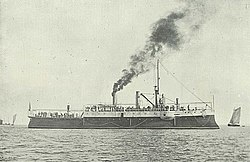Pátria (gunboat)
|
The Pátria under steam
|
||||||||||||||||
|
||||||||||||||||
|
||||||||||||||||
|
||||||||||||||||
The Pátria ( German : Vaterland) was a gunboat of the Portuguese Navy . It was built in the Arsenal da Marinha in Lisbon . It was financed with donations from Portuguese people who had emigrated to Brazil . The trigger for the fundraiser was the British ultimatum of 1890, with which Great Britain forced Portugal out of Rhodesia and Nyassaland . The British even sent warships to Lisbon to exert pressure.
history
In 1905 the Pátria began its service in the naval division (Divisão Naval) South Atlantic based in Luanda . For nine months the gunboat mapped the most important ports in Brazil and was the first warship to travel up the Amazon as far as Manaus . After a short stay on the Cape Verde Islands , the Pátria returned to Lisbon in mid-1906. In 1908 the Pátria was transferred to the Macau naval base for use in the Far East fleet. Here she went against pirates, among other things. For example, between July 12 and 19, 1910, when Portuguese policemen freed several Chinese children from pirate hands on the island of Coloane under the fire protection of the Pátria and the gunboat Macau . The Pátria was at that time under the command of First Lieutenant José Campos Ferreira Lima.
The then second lieutenant Jaime do Inso reports in detail on the Pátria's deployment in the Manufahi rebellion in Portuguese Timor in 1911/1912 under the command of Lieutenant Gago Coutinho (April to June 1912). The Pátria reached the capital Dili on February 6, 1912. It remained in action in the waters around Timor for eight months . In the meantime she was only briefly ordered back to Macau, but returned to Timor in April, where she bombed Betano on the south coast of Timor. According to Inso, 1,000 people are said to have died in the action in which Boaventura , the leader of the rebels, was captured. In addition, the Pátria fought rebels in Oecussi . The marines also fought on land and defended some towns. So the second largest town Baucau between June 29th to July 25th 1912. On August 16, 1912 the state of emergency for the colony was finally lifted again. Parallel to the missions, the Pátria carried out mapping work on the Timor coast. In 1916 the gunboat was again ordered to Timor to protect the colony against German warships during World War I and in the event of the Netherlands entering the war on the side of the Central Powers .
Between 1921 and 1924, the Pátria Joaquim commanded Marques Esparteiro , who later became the governor of Macau .
In 1931 the Pátria was decommissioned from the Portuguese Navy and handed over to China . In the Chinese Navy the gunboat served under the name Fu Yu until 1937 .
A model and a painting of the Pátria are now in the Naval Museum in Lisbon .
See also
literature
- Monika Schlicher: Portugal in East Timor. A critical examination of the Portuguese colonial history in East Timor from 1850 to 1912 . Abera, Hamburg 1996, ISBN 3-931567-08-7 , ( Abera Network Asia-Pacific 4), (also: Heidelberg, Univ., Diss., 1994).
- Jaime do Inso : Em Socorro de Timor . Lisbon 1913, (new edition under the title "Timor - 1912" . Edições Cosmos, Lisbon 1939 and under A última revolta em Timor 1912 , Lisbon 2004), (Portuguese).
supporting documents
- History of Timor - Technical University of Lisbon (English; PDF file; 805 kB)
- Revista da Armada: Jaime do Inso ( Memento of August 14, 2007 in the Internet Archive ) (Portuguese)
Individual evidence
- ↑ a b Portuguese Gunboat Macau ( Memento from June 14, 2011 in the Internet Archive )
- ↑ Museu da emigração e das comunidades, Luísa Maria Gonçalves Teixeira Barbosa, O Contributo da Comunidade de Portugueses no Brasil para a Consolidação do Republicanismo em Portugal (1890-1910) ( Memento of January 22, 2012 in the Internet Archive )
- ↑ Revista da Armada: Jaime do Inso ( Memento of August 14, 2007 in the Internet Archive ) (Portuguese), accessed on June 12, 2012.






